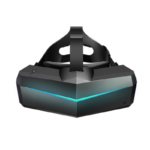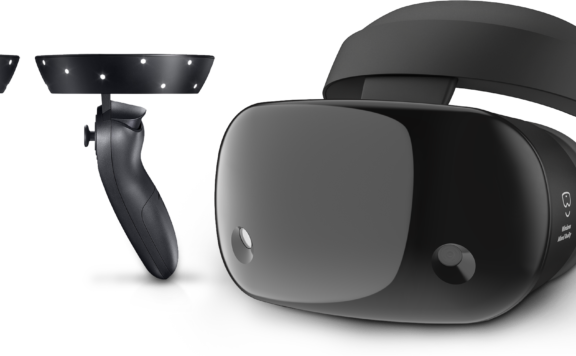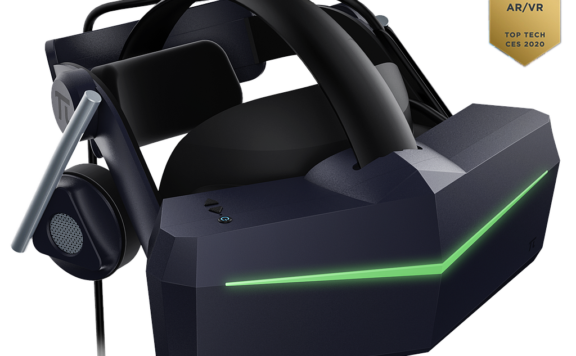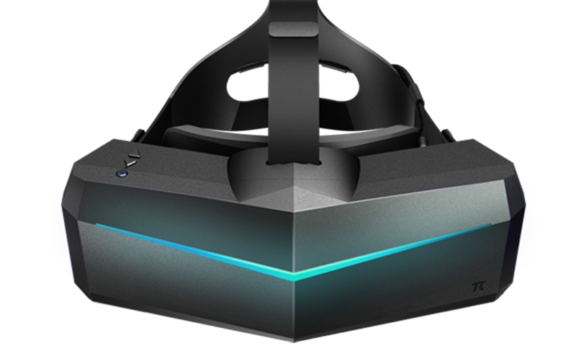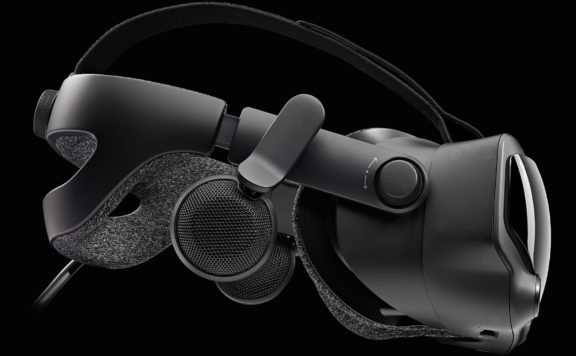The Pimax Artisan is the new Pimax entry level VR headset. Priced at $449 for the headset only it directly competes against the Valve Index ($499) in the market of SteamVR Lighthouse Tracking compatible VR headsets.
In this preview you will find out why the Pimax Artisan is not quite yet the Valve Index killer but still one of the most exciting Pimax headsets to date and why in my opinion it could be a feasible option not just for VR enthusiasts but for anyone who is looking for a new VR headset with a big FOV.
Overview
The Pimax Artisan is fully compatible with SteamVR Lighthouse tracking. To be able to use it, you will need SteamVR base stations and compatible controllers. This makes the Artisan an interesting upgrade option for those consumers that own first generation lighthouse setups, like owners of the original Vive.
For those who would like to go for the Artisan and do not yet own base stations and controllers, Pimax is offering a complete bundle that includes Valve base stations (v. 2.0) and Valve Index controllers for $948. The headset therefore is more of a Valve Index than a Rift S competitor, since the Rift S can be purchased for $399 and already includes everything that is needed to dive into VR. Therefore I will focus on the Valve Index for the in depth comparisons in the remainder of this preview.
The Pimax Artisan retains the wide FOV that became a trademark for Pimax headsets. At a maximum of 170° diagonal FOV it offers still a wider FOV than the Valve Index with its 135°. It does not quite reach the 200° of the Pimax flagship models 8K X and 8K Plus though. That is actually more of a blessing than a curse and we will talk about that later in this preview.
As far as the displays are concerned, the Artisan sports 2 LC-Displays with a resolution of 1700*1440p per eye and a max refreshrate of 120hz. That is quite a step up from the Rift S (1280*1440px, 80hz) and a bit of a higher resolution than the Valve Index (1600*1440pixels per eye). Despite the slightly lower resolution the Index displays are capable of a higher 144hz refresh rate though.
Build Quality, Comfort and Features
Unlike the more expensive Pimax models the Artisan does not ship with the rigid modular audio strap but rather with a conventional elastic strap similar to those of the previous Pimax models.
To increase comfort despite coming with this simplistic elastic head strap the Artisan sports the so called “comfort kit”, an improved facial interface that features a much broader area for the forehead to rest on.
Unlike previous Pimax models the Artisan model that arrived at the MRTV Headquarters included over ear headphones that are directly connected to the head strap. This kind of style was first introduced with the Pimax 4k and at the time received rather positive reviews.
Other than that the Artisan can not be distinguished from previous 5K/8K Pimax models. It uses the same housing that comes with IPD adjustment wheel, on/off button, volume rockers, a single 3.5mm audio jack and 2 USB-C connectors for future upgrades like the eye tracking or the hand tracking module, that will both be compatible with the Artisan.
Thanks to the comfort kit the headset indeed is way more comfortable than the previous Pimax models. However, it cannot quite compare to Valve Index and Pimax 8K X/Plus in terms of comfort and ease of use. All of these competing headsets offer rigid head straps that simply can be adjusted by turning a single adjustment wheel at the back of the strap.
For users that do not have to share the headset with others and therefore do not need to readjust the head strap every single time the headset is used, the elastic straps in conjunction with the comfort kit might be a quite acceptable solution. It does feel outdated though when taking into consideration that the Valve Index offers a way superior solution for a similar price.
Also in terms of build quality the two headsets are worlds apart. The Valve Index offers far superior quality housing and overall workmanship. The Index simply feels like the more complete and better engineered device that is no match for the Artisan at all.
Displays, lenses and FOV
Next to comfort of course picture quality in VR is of major importance when making a purchase decision. The Artisan offers a surprisingly great picture quality that is a joy to look at in VR.
The two RGB stripe matrix LC-Displays sport a resolution of 1700*1440p per eye and even though that is less than the 2560*1440 per eye resolution of the Pimax 5K Plus, the picture looks even slightly better with a less perceivable SDE than the former entry level Pimax headset.
The reason probably is a smaller display size which would also explain the smaller maximum FOV of 170° as compared to the 200° FOV of the other Pimax models. As hinted at before, the decrease in FOV actually is not a disadvantage at all, but instead a blessing in disguise.
The 170°FOV allows for fantastic immersion and is noticeably wider than that of the Valve Index. Yet, there is barely any noticeable distortion, a problem that all the other Pimax headsets are plagued with. Of all the Pimax models the Artisan is the Pimax headset with the least amount of distortion, finally making this the first Pimax that might be a feasible option not only for the hardcore VR enthusiast but also for the general consumer.
Another advantage as compared to the other Pimax models is the increased binocular overlap. For the Artisan, I feel way more comfortable focusing on objects right in front of me at the center of my vision. The ultrawide FOV Pimax models seem to decrease binocular overlap in order to maximize FOV at all costs. The 170° FOV of the Artisan might just be the sweetspot for Pimax going forward to still offer higher FOV headsets with a better immersion while retaining viewing comfort for the users. After hours of playing I could finally come out of a Pimax headset without feeling ANY kind of eye strain and that quite excites me about the Artisan.
Colors and black levels are generally on par with the previous Pimax displays. In direct A-B comparisons with the Pimax 5K Plus colors looked more vibrant and generally preferable over the entry level predecessor. In direct comparison with the Valve Index the Artisan cannot quite reach the quality of the Index displays when it comes to colors and black levels. The same is true for sharpness and visible screen door effect, both is better on the Valve Index. The Artisan does have an edge though when it comes to the size of the sweetspot, the area where the user sees the sharpest picture. That area is bigger on the Pimax headset and that should have to do with its big lenses.
The lenses are just the same fresnel lenses that had been used on all the recent Pimax models. They do a decent job and have one big advantage over the Valve Index lenses: they introduce way less glare. God rays are a big problem of the Valve Index and consumers who have dismissed the Index because of this shortcoming might want to check out the Artisan instead. The god ray problem is not perfectly solved here but it is way less pronounced than on the Valve Index.
Audio
The headphones that came with my Artisan are quite a good audio solution.
They do a good enough job to keep you immersed into the virtual worlds you are visiting. I prefer this sound solution a lot over the open ear approach of Rift S and Quest for example.
The headphones sound good but not great and lack quite a bit in the bass department. In direct comparison to the Valve Index audio solution, they cannot quite compare at all though. But again for typical day to day use and if you do not belong to the audiophile community they will do a good enough job.
Also the microphone that is built into the Artisan will not disappoint and your fellow team mates in multiplayer games or your livestream viewers will hear you loud and clear although also in this category, the Index impresses with a superior offering.
Benchmarks
The Artisan is marketed as an entry level headset that can be used by anyone with at least a GTX 1050Ti/1060. I had no problems at all running the headset with my 1080ti which does not come as a surprise.
On my GTX 1080ti system and the Artisan (SteamVR Supersampling set to automatic, render resolution 2288*2416) I receive an Open VR Benchmark score of 33 fps, a very respectable result.
The same bechmark results in 43 fps on the Valve index with a render resolution of 2016*2240 (SteamVR SS at 100%) on the same computer.
For all of you who are not familiar with the Open VR Bechmark tool: results below 90 fps are rather the norm than an exception. The same scene will be tested with the different headset/GPU combinations and the resulting frames per second will be counted.This value can then be compared with other headset/GPU combinations.
Simply run the free tool on your current set up to find out how many fps you would get with the exact same Open VR benchmark scene. It is safe to say that for the Artisan you do not need the latest and greatest GPU for a good experience.
Tracking/Controllers
For the sake of this preview I have used the Artisan with Valve Index controllers and Valve Lighthouse base stations (1.0). Just as expected, tracking of the headset is flawless and the Index controllers performed just as expected.
Around CES 2020 Pimax had also teased a version of the Artisan that would come with the Nolo tracking system and the Nolo controllers as an alternative to Valve Lighthouse tracking. I had no chance to review that solution and I also could not find any mention of it on the Pimax website anymore. Should it still release I will for sure review it in a separate article.
Software compatibility/Ease of set up
The Pimax Artisan, just like all the other Pimax headsets, is fully compatible with all of the SteamVR library. The software needed to run the Pimax headsets (Pitool) is even capable of running Oculus Rift games without the need to use an additional tool like for example ReVive.
Setting up the headset is way easier than you might come to expect from a Pimax headset and will only take a couple of minutes. The software has come a long way from the early days of the Pimax 8K Kickstarter and the default settings should be totally fine for the big majority of consumers who will use the device.
Conclusion
The Pimax Artisan is one of the most exciting Pimax headsets to date. It offers a wide FOV VR experience that is not impaired by distortions in a way that previous Pimax models were. The attractive price will also make it a viable option for many who want to replace their first generation lighthouse headsets with a wide FOV headset.
If it came in at the same current price but would include the Deluxe Modular Audio Strap of the 8K X and the same quality housing, it would be tough not to recommend the Artisan over the Valve Index for its increased FOV and the absence of god rays. As it stands right now though, coming with the simplistic elastic strap, worse audio solution and overall inferior build quality, the Valve Index is still the headset to beat and my recommendation for VR enthusiasts who are looking for the best overall VR package out there.
For those consumers that are looking for a wider FOV headset though that is not plagued by god rays in a way that the Index is, the Artisan is an exciting option that is well worth a purchase.
